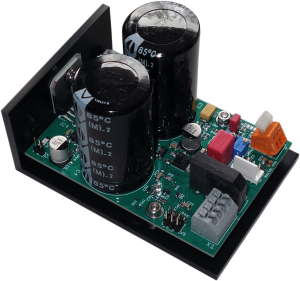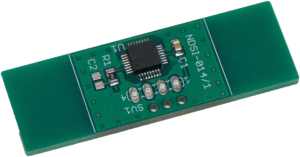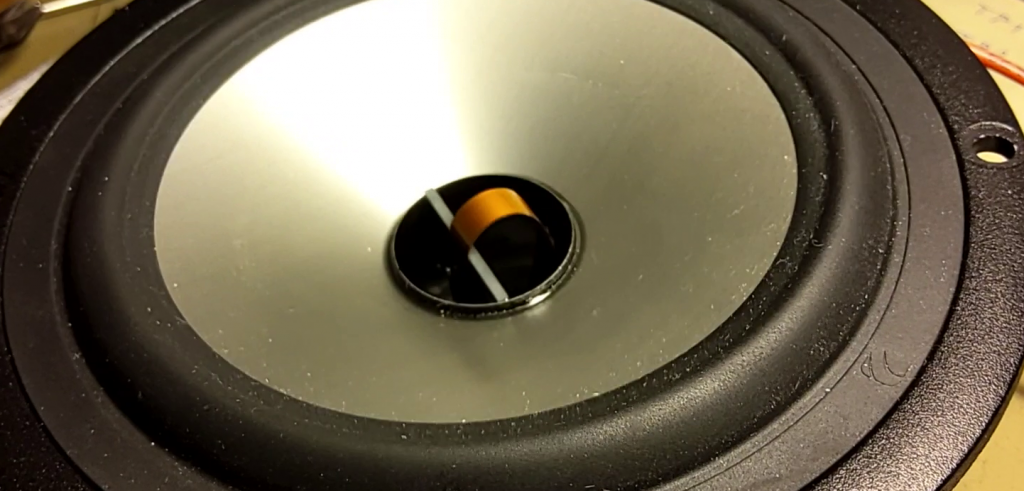High-End Power Amplifier with on-board MFB* controller for active MFB* speakers with perfect SPL** frequency response and inaudible distortions
is product is available for designers and manufacturers of High-End speaker systems and can easily be adapted to different speaker chassis from different manufacturers
Recommended for middle- and deep-tone loudspeakers and sub-woofers


* Motion Feed Back, ** Sound Pressure Level
Our unique selling proposition for your superior products:
Even well developed and carefully manufactured speaker chassis reach in general only linarites, which result in harmonic distortions around 1 % – and this holds only for small membrane amplitudes, i.e. higher frequencies. At low frequencies and high SPL even High-End speaker systems from well-known manufacturers show 10 … 30 % harmonic distortions.Harmonic distortions are often brushed aside as “less disturbing”, with the argument, that each music instrument generates harmonic content itself. An argument that sounds logical on a first glance, but does not hold at a closer view.
The non-linarity, which generates the harmonic distortions generates at equal level non-harmonic intermodulation frequencies. Those alias frequencies can be heard very well and are very disturbing. Here is a brief introduction to motion controlled (motion feed back, MFB) speaker systems …
If one wants to reduce the lower frequency limit of the speaker system to values below 32 Hz, i.e. into the lowest octave of the human hearing, and/or if one wants to reduce the non-linarites of the speaker chassis in that frequency range below 1 % (-40 dB), then MFB is an appropriate technology.
A sensor measures the travel, velocity or acceleration of the speaker membrane and a closed control loop ensures, that any deviation from the ideal value is immediately corrected. In an ideal case – and we at AudioChiemgau can approximate that ideal case extremely well – only the non-linearity of the sensor and its frequency response determine the overall characteristics of the MFB speaker. Especially the advances in the MEMS-technology allow now to build nearly perfect speakers.The amplifier module AC-PAR75 uses that new technology. The measured acceleration signal of the speaker membrane is compared with the audio input signal and closely controlled. This innovative technology allows on one hand to extend the SPL frequency response of a speaker far below its original resonance frequency (16 Hz are achievable even for small speakers) and on the other hand, it drastically reduces the non-linearity of the speaker (harmonic distortions between 0.1 and 0.03 % for the third order component are achievable). Even small high-end speakers with very low corner frequency become such feasible.Our AudioChiemgau caveat: The MFB control loop would keep the SPL constant even at very low and at infra-sound frequencies. Physics tells, that the amplitude of the speaker membrane increases quadratic reciprocal to the frequency at constant SPL. Halving the frequency results therefore in a factor 4 increased membrane amplitude. AudioChiemgau recommends to use a second order e.g. 15 Hz high pass filter in front of the AC-PAR75. This avoids excessive membrane amplitudes caused by an uneven vinyl record, usually in the 0.5 to 4 Hz range, but even high quality digital recordings show often enough infra-sound components. Our AudioChiemgau Analog Audio Processor AC-AAP is optimized for the combination with our amplifier modules and has this filter built in. For high SPL at low frequencies we recommend to use several AC-PAR75 and speakers in parallel. Physics tells, that the SPL is proportional to the displaced air volume. Therefore an enlargement of the membrane area through several parallel systems is sensible if very high SPL is required.
The AC-PAR75 comprises two components:
a) A small and light weight sensor PCB which will be fixed in the voice coil
b) The compact integrated amplifier/MFB-controller module
